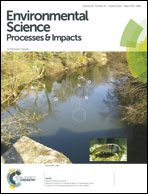Organic removal assessment at full-scale treatment facilities using advanced organic characterization tools†
Abstract
The character of dissolved organic matter (DOM) in source water determines its treatability in drinking water treatment. In order to understand and improve drinking water treatment process operations, advanced characterization tools, three-dimensional excitation emission matrix technology (3D-EEM) and high-performance size exclusion chromatography (HPSEC), have been used. The DOM characteristics in both source and treated waters from 52 full-scale drinking water treatment plants of 23 cities in China were investigated. The dissolved organic carbon (DOC) concentration was similar as compared with other countries; however, differences in the compositions of DOM between Chinese water sources and those of other countries were observed. The assessment confirmed that the origin of DOM is the key factor influencing its removal. Source water with the lowest anthropogenic source had the best DOC removal. According to the principal component analysis result of DOM characteristics, the source waters were found to be divided into two groups based on geographic location. Source waters in the east, north and center of China where there are larger populations tend to cluster together; while those of the southwest, northwest and south of China tend to cluster together. These densely populated areas in China should face a bigger challenge of DOC removal during drinking water treatment. Moreover, it was concluded that more attention should be paid to advanced coagulation or hybrid treatment in the actual water treatment train because of the significant increase of the middle molecular weight fraction (1000–2000 Da) after coagulation treatment.


 Please wait while we load your content...
Please wait while we load your content...